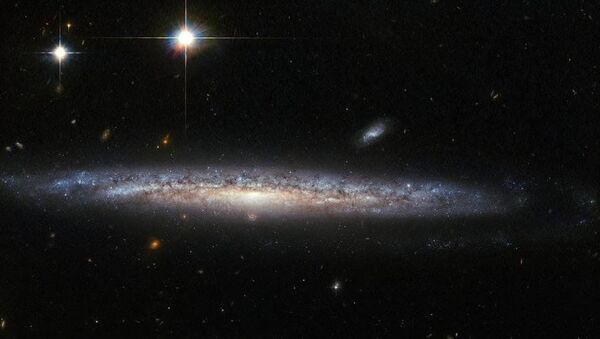The National Aeronautics and Space Administration (NASA) has published a photo of the galaxy NGC 4380, which the US space agency said looks like a special effect from a science fiction or fantasy film, “swirling like a gaping portal to another dimension”.
At the same time, NASA explained that NGC 4380, which was captured in a photo by the Hubble Space Telescope, is “actually quite ordinary” and that such galaxies are “common in the universe”.
This is not a gaping portal towards another dimension from a Science Fiction movie, but the very real galaxy NGC 4380. Credit: @ESA / @Hubble_Space / @NASA , P. Erwin https://t.co/9GHirmhjLy pic.twitter.com/65fyswHvJ9
— HUBBLE (@HUBBLE_space) October 14, 2019
“These colossal collections of stars, often numbering in the hundreds of billions, are shaped like a flat disk, sometimes with a rounded bulge in the centre. Graceful spiral arms outlined by dark lanes of dust wind around the bulging core, which glows brightly and has the highest concentration of stars in the galaxy,” NASA noted.
NGC 4380 is located about 45 million light years from Earth, in the constellation of Virgo.
Its photo was published shortly after NASA released an image of NGC 3717, a spiral galaxy, which was detected in the constellation of Hydra (the Sea Serpent) and which resembles a Frisbee; the photo was also made by the Hubble Telescope.
According to NASA, the closer part of this galaxy is "tilted ever so slightly down, and the far side tilted up", allowing for a view of the central bulge and across the disk.
#HubbleFriday Seeing the profile of galaxy NGC 3717 can provide a vivid sense of its three-dimensional shape. Spiral galaxies are mostly thin disks, but they have bright, spherical, star-filled centers that extend above and below: https://t.co/udIHfCXo9z pic.twitter.com/4fsXRuhMm2
— Hubble (@NASAHubble) October 11, 2019
This was preceded by publication of another interesting photo by the US space agency in August, which showed “extreme consequences” of a pair of galaxies interacting with each other.
The galaxy IC 1727’s structure was “visibly twisted and asymmetric, and its bright nucleus has been dragged off-centre”, the Hubble Telescope’s website said, referring to a powerful impact by another galaxy, NGC 672.




